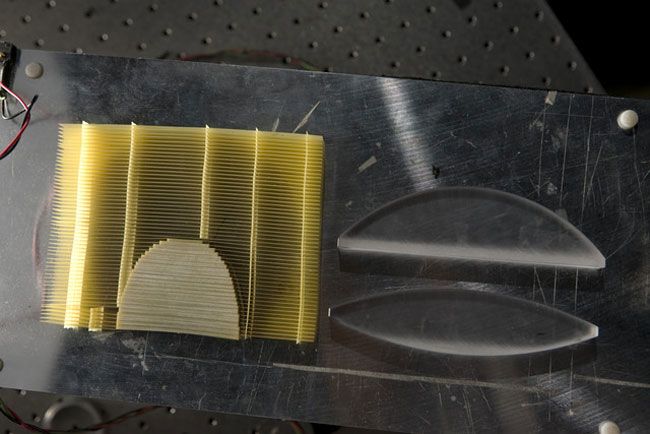New Lens Could Produce Better Camera Images

A new lens resembling tiny Venetian blinds can precisely focus the direction of microwaves and could lead to better digital cameras and other imaging devices, scientists say.
The lens, made using a class of man-made substances called metamaterials, may eventually replace conventional lens designs by combining sharper images with a 180-degree wide angle field of view.
"Radar systems and camera systems — even simple personal camera systems — have the potential to benefit from a lens design similar to what we have shown," said Nathan Kundtz, an electrical and computer engineer at Duke University.
Metamaterials represent a combination of materials that create new effects not normally seen in the natural world. The metamaterial lens measures just 4 inches (10 cm) by 5 inches (13 cm), with less than 1 inch (2.5 cm) height, and consists of 1,000 pieces of fiberglass materials etched with copper. The pieces sit in parallel rows that can precisely direct passing electromagnetic rays — in this case microwaves.
Researchers at Duke University in Durham, North Carolina used the metamaterials to recreate the effect of a spherical Gradient index (GRIN) lens, which uses a ball shape to continually bend the path of passing light or other electromagnetic waves.
"Instead of using the surfaces of the lens to control rays, we studied altering the material between the surfaces," Kundtz said. "If you can control the volume, or bulk, of the lens, you gain much more freedom and control to design a lens to meet specific needs."
A GRIN lens can eliminate the image distortions that arise from other lens shapes that only bend the path of light where it enters and exits the lens. But its spherical shape creates images that are incompatible with the flat detector arrays used in digital cameras and many imaging devices.
Sign up for the Live Science daily newsletter now
Get the world’s most fascinating discoveries delivered straight to your inbox.
By contrast, the new metamaterial lens may work in such devices because it creates a flat image. David Smith, head of the Duke University lab responsible for the recent breakthrough, described the new lens as "GRIN on steroids."
The Duke University researchers previously used a similar metamaterial approach to demonstrate an “invisibility cloak” that could deflect microwaves. But unlike the cloaking method, the team’s new lens could soon find its way into consumers' hands.
Making the metamaterial lens work for visible light as well as microwaves may require some more engineering tricks, Kundtz told TopTenREVIEWS, but the materials exist to make it work.
"There's plenty of room for clever engineers and inventors to implement these ideas in devices," Kundtz said.
The research is detailed in the Dec. 20 issue of the journal Nature Materials.
This article was provided by TopTenREVIEWS.












